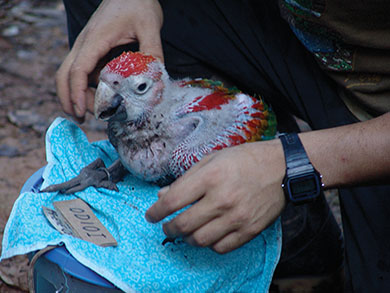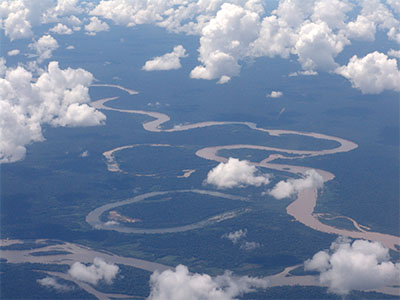An International Look at One Health
“My children need to see a world that has the beauty and wonder of species that we live in now,” said Dr. Donald Brightsmith, assistant professor in the Department of Veterinary Pathobiology at the Texas A&M College of Veterinary Medicine & Biomedical Sciences (CVM). “Biodiversity and ecosystems matter because we’re all part of it.”

Brightsmith has been passionately pursuing research aimed at gaining a better understanding of the delicate balance of ecosystems, and the many species that rely on them, through his work with the Tambopata Macaw Project based in Tambopata, Peru. Also, as co-director of the Applied Biodiversity Science Program at Texas A&M, part of an integrated research and teaching grant, Brightsmith oversees multiple projects that advance understanding of the majestic macaws that feed on the clay licks near the research station and also provide educational opportunities for government officials, naturalists, and other researchers to learn more about the importance of conservation.
With a growing logging enterprise in many heavily forested areas in Peru, as well as increasing urbanization, there are a number of threats to the native species of plants and animals that depend on the heavily wooded area for food and shelter. Those that live in developed countries are often insulated from the impacts of ecosystem degradation, so Brightsmith, his collaborators, and a team of volunteers are working to measure the impact of environmental change on multiple species.
“We are working on research projects that we hope will help define the direction for conservation and education efforts so that future generations will be able to appreciate the unique role each species plays in a successful ecosystem,” Brightsmith said. “When you tip the balance away from healthy ecosystems, the environment can collapse for animals and humans. We spend a lot of time documenting the surroundings, measuring how things are working in protected areas, and monitoring the animals. We learn the scale at which different species live.”
Using satellite telemetry to track the macaws that frequent the nearby clay licks, Brightsmith and his team have been able to identify that many of them fly out of the protected area, which is currently the size of Connecticut, and over urban areas, extending their territory much further than previously thought. Information like this may then be used by governments to determine appropriate boundaries for designated protected areas.
Natural resources and feeding habits are also important to improving conservation efforts. Brightsmith has been studying the feeding of macaws at the nearby clay licks. Contrary to similar clay licks in Costa Rica, the ones near Tambopata appear to fulfill a different nutritional need for the Peruvian macaws.
“In Costa Rica, the clay licks are made up of different minerals than those in Peru,” said Brightsmith, “and appear to fulfill a need for high sugar content. The clay licks near Tambopata were created when the ocean encroached into the soil leaving a higher sodium content. So this difference in nutrient need is key to understanding the successful protection and growth of the macaw population. If we don’t do our part by increasing what we know about macaws and their behaviors, we can push this species and others to the point of being ecologically extinct, which means they are unable to fulfill their full ecological purpose for being in the ecosystem. At that point, we lose something valuable for future generations.”
However, Brightsmith’s work is about more than just macaws. Peccaries and other species that live in close proximity to the clay licks have led to new questions for the researchers and volunteers at the Tambopata station.
“We recognize that herbivores in the area, like the peccaries, serve as seed dispersers, as do other species of birds,” said Brightsmith. “We observe them as they visit the clay lick area to try to gain a better understanding of the role the clay lick serves as a sodium source, and then we question how the concentration of herbivores near a sodium source can potentially change seed/seedling forest dynamics.”
Through outreach efforts based in Tambopata, like the Amazon Field School, and with additional volunteer opportunities, Brightsmith is finding new ways of looking at conservation by bringing people into the picture.
“By keeping a broad focus on what we are doing here,” said Brightsmith, “we are able to create new perspectives on conservation where we can look at what we are doing from both anthropological and biological points of view.”
Brightsmith also encourages the next generation of conservation researchers to embrace this One Health approach through his teaching role in the Schubot Center for Exotic Bird Health located within the CVM. The Center is under the leadership of Dr. Ian Tizard, distinguished professor of immunology in the Department of Veterinary Pathobiology. Tizard, through his own teaching and research efforts, also recognizes the inextricable link between animal, human, and ecosystem health that is at the core of the One Health Initiative.


“Of all emerging diseases, approximately 70 percent are zoonotic, meaning they affect both humans and animals,” said Tizard. “Also, nearly 95 percent of emerging diseases are derived from animals. While we have known, for example, that sick birds can lead to sick cats, which in turn lead to sick humans, we are taking a much deeper look at disease chains. In doing so, we cannot be too narrow in the approach.”
Work within the Schubot Center not only includes Brightsmith’s parrot and conservation projects, but also genomics of multiple species of birds and a growing number of projects focused on waterfowl.
“We have a constituency of aviculturists,” said Tizard. “We need to deliver to the concerns of bird enthusiasts and bird owners. There are an awful lot of questions to answer out there when it comes to providing evidence-based information to improve the health and welfare of birds whether wild or domestic.”
One of the more pressing concerns for the researchers within the Schubot Center is that it appears some ecosystems are approaching a tipping point. Tizard pointed out that these ecosystems are witnessing less genetic diversity, increased predatory stress, increased environmental stress, disease introduction, and nutrition stress.
“Our focus has been on the health of populations of birds, be it captive or wild,” said Tizard. “We are fortunate to have a strong partnership with clinical specialists here at the CVM, and that provides added depth to what we are able to accomplish from a research perspective.”
One important study that Tizard says represents the growing focus on avian infectious diseases and the interplay between animal health and the environment is the Center’s work on proventricular dilatation disease (PDD), which the Center conclusively proved is caused by the avian bornavirus. PDD was primarily thought of as a lethal disease affecting large parrots. It is described as a devastating and complicated disease to study. However, once avian bornavirus was determined to be the cause, it has led the research team at the Schubot Center in some interesting directions.
“We have now seen the virus in a number of waterfowl species,” said Tizard. “In fact, nearly 10 percent of Texas ducks have tested positive for the virus. This disease, which spreads similarly to influenza, has the potential to wipe out a species, and even small changes in the environment can increase the risk for this disease in some species.”
Avian bornavirus affects the vision and eyesight of infected birds, and may be shown one day to be the reason birds often fly into planes and other obstacles. The virus also poses other questions for the Schubot team. Researchers in the Center are trying to determine how the virus is able to infect parrots and waterfowl-two genetically different species. At the same time, some birds are able to live with the virus while others get sick. Of particular concern is if this disease occurs in wild birds, and if it is able to jump between both wild and domestic birds. This finding would have huge implications for avian release and recovery programs as it would become important to determine if the birds released back to the wild are healthy and disease-free, and if not, what the impact on the environment and other wild bird populations would be. The team is also investigating the reported appearance of the virus in populations of ground squirrels in West Texas, which would be a significant jump in species to monitor.
“There is no denying that the health of animals, humans, and the ecosystem are linked,” Tizard said. “For this reason, researchers like Dr. Brightsmith and others have to continue to use this One Health perspective to ensure that we have a healthy and sustainable level of biodiversity of all species for future generations to enjoy.”
Whether through improving conservation and outreach, or solving the complexities of avian diseases, the work of the Schubot Center is essential to advancing knowledge for future generations of researchers, as it extends the research and clinical expertise from the CVM to Tambopata and beyond.


